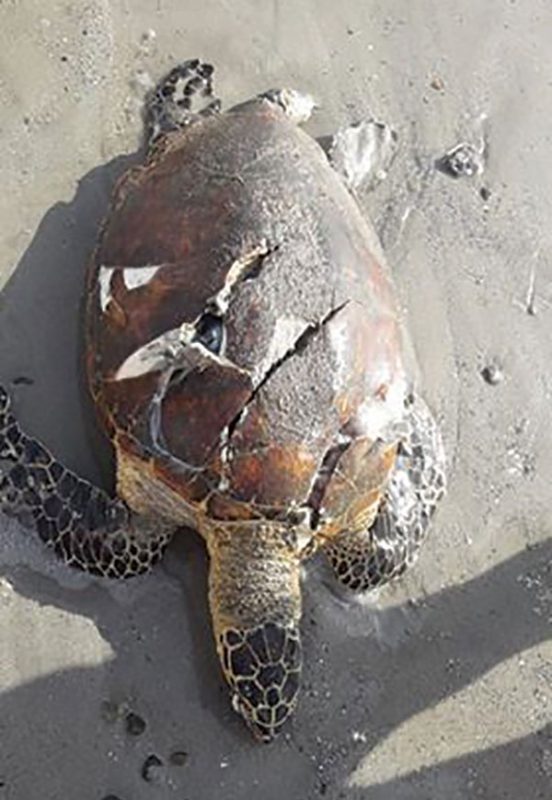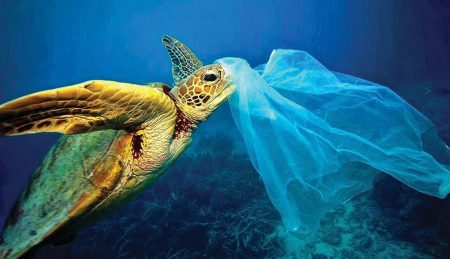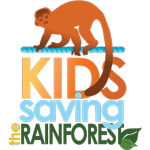Karma Saving the Rainforest – August 2018

Hi again Quepolandia readers! It’s Karma, the spokeskid from Kids Saving the Rainforest!
This month I have a very important message to share with you, and that is about the importance of boating safety and protecting the very special marine animals that share this beautiful place in the world with all of us.
I learned this lesson from a graceful animal called the sea turtle! Let me tell you how it happened. Recently, my amazing mama and I were walking on the beach when we came across two lifeguards carrying something large out of the water. We went over to see what it was, and we realized it was a large Hawksbill sea turtle!
There were three big gashes cut into the shell. We hoped at first that we could call one of the groups in the area that work with sea turtles to help rescue it. Unfortunately, this poor turtle was already dead and it was too late to help her. We asked one of the lifeguards named Jhonny Lopez, what had happened.
Jhonny teaches surfing lessons, and he also volunteers his time as a lifeguard helping to keep everyone safe on the beach. He explained to us that the turtle had been sliced by the propeller of a boat and had washed up on shore. Some people were not showing any respect to the body, bothering it a lot, and he and the other lifeguard had moved it to safety while the turtle was reported to MINAE, the government agency who helps wildlife. My mama had their number in her phone, so she sent a message right away!
Jhonny told us that many boats and jet skis come way too close in the waves to the shore, and that is very dangerous for both animals and people! He said this poor turtle might have been coming in to shore to lay her eggs. Sea turtles always return to the beach where they hatched to lay their eggs, and this turtle Mama might have been coming to this very same beach for years and years before the boat took her life!
That was a very sad experience, but it was also a lesson. I knew I was on the beach that day and saw the turtle for a reason, and now I am going to spread her message and try to make a difference for all the other amazing sea turtles who are still here with us.
Turtles all around the world are beginning to fade from this planet. Danger from boats is just one of the threats they face.
 Another is marine debris. Due to littering, trash is infesting the oceans, causing animals like turtles to come across it very often. For a turtle, one of the main problems are plastic bags. One of a turtle’s main food sources are jellyfish. And from a turtle’s point of view a plastic bag looks identical to a jellyfish. If the turtle eats the plastic bag it will end up choking. They can also get caught in all that plastic, stopping them from being able to swim, eat, or even live! If you are fishing, make sure you don’t drop fishing hooks or lines into the ocean as these are very dangerous to animals. Around 100,000 marine animals die a year from marine debris.
Another is marine debris. Due to littering, trash is infesting the oceans, causing animals like turtles to come across it very often. For a turtle, one of the main problems are plastic bags. One of a turtle’s main food sources are jellyfish. And from a turtle’s point of view a plastic bag looks identical to a jellyfish. If the turtle eats the plastic bag it will end up choking. They can also get caught in all that plastic, stopping them from being able to swim, eat, or even live! If you are fishing, make sure you don’t drop fishing hooks or lines into the ocean as these are very dangerous to animals. Around 100,000 marine animals die a year from marine debris.
Lots of people every year travel to Costa Rica just to see sea turtles lay their eggs, and later to watch the babies hatch and make their way out into their ocean home. In November, I am very lucky I will be joining my school Life Project Education to see some of these baby hatchlings going out to the ocean for the first time! We will be working with another great non-profit helping wildlife in this area, the Matapalo Sea Turtle Conservation Project!
But we have to think of the turtles all the time, not just when we can see them! If you are boating or using a jet ski, pay extra careful attention to where you are going and avoid hitting any marine life that might be floating there in the water! Slow down, and avoid boating over beds of sea grass which is the sea turtle’s habitat! Have a person on board whose job it is to watch out for any marine animals. They can wear polarized sunglasses to cut down on the glare of the sunlight on the water, making it easier for them to spot an animal and avoid hitting it!
Don’t have lights on the beach at night. This can confuse turtles who use the light of the moon to find their way to the water. Even bonfires during nesting season can lead these turtles in the wrong direction!
Last but not least, spread the word! If you see a problem like I did, speak up and do something about it! The planet needs the help of people like us who want to make it a better place!
Don’t forget, if you find orphaned or injured wildlife, send a WhatsApp message to the Kids Saving the Rainforest veterinary team at 88-ANIMAL and we can help! You can also take a guided tour of our Wildlife Sanctuary every day except Tuesday at 9 am to meet some amazing animals and learn about the important work we are doing trying to save them. You never know, you might just see me there!

